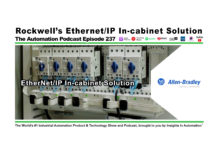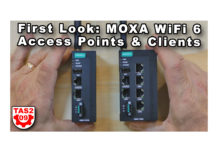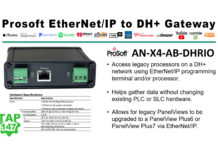
One of the best courses I took back in the 90’s was an Ethernet Networking course.
At the time I was already familiar with DH+, DH-485, and RIO, and like most people I connected to the Internet through a dial-up service like AOL.
Fast forward twenty years, and now most of us access our automation systems, control I/O, and surf the Web via Ethernet.
But while we all may be using Ethernet, I was recently reminded that some folks could still use a primer on Ethernet basics.
So in today’s article I’ll cover what I consider the essential wired Ethernet hardware basics, while also providing links for those who’d like to learn more.
Wired Ethernet Cabling
When Ethernet first became commercially available in the early 1980’s, it used coaxial cable (aka “coax”) similar to what Cable TV uses.
The original thick cable was known as 10BASE5, while the later thin coax was known as 10BASE2.
 Coax is a shared “broadcast” medium, which means only one network device could successfully transmit a message (aka frames of a stream of data) at a time.
Coax is a shared “broadcast” medium, which means only one network device could successfully transmit a message (aka frames of a stream of data) at a time.
When two devices tried to transmit at the same time, it would lead to a transmission “collision.”
These “collisions” typically resulted in no usable data being received by any of the intended destination devices.
To address this, a scheme known as CSMA/CD (Carrier Sense Multiple Access with Collision Detection) was implemented.
It not only reduced the chances of multiple devices attempting to transmit at the same time, when a collision did occur it attempted to resolve it by instructing the transmitters to each wait a random time interval before trying to re-transmit.
For a more detailed explanation of how CSMA/CD works, check out this article HERE.
One downside of using coax was that a single break in the physical network would result in network devices becoming disconnected from each other.
This would often disconnect users on one side of the network break from devices they needed access to, like printers and file servers, on the other side of the break.
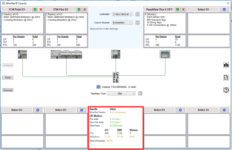
For this and other reasons, most of the industry moved to the “Star” based networks we use today.
Unlike 10BASE5 and 10BASE2, where all devices were connected to one single “trunkline,” in Star networks all devices are wired directly to a central device like an Ethernet Hub or Switch.
The advantage being that the failure of a single device cable doesn’t take the entire network down.
The point-to-point cables used in these early Star networks used multi-conductor Unshielded Twisted Pair (UTP) cabling, which became standardized as 10BASE-T (and later succeeded by 100BASE-TX, 1000BASE-T and 10GBASE-T.)
Today we know these point-to-point UTP cables as Ethernet Patch Cables, and most modern patch cables meet either the Category 5E (1GB) or 6 (10GB) standards.
For more about Ethernet Patch Cables including pinouts and wiring, check out this article HERE.
Hubs and Switches
Star based networks require central, multi-port repeaters to accept and rebroadcast Ethernet transmissions received from devices.
Early on, most installations used simple “Ethernet Hubs” which basically re-transmitted any message received on any port to all the other ports.
This limited functionality made Ethernet Hubs simple and cheap to produce, but also made them inefficient in some applications as rebroadcasting every transmission to every port did nothing to mitigate collisions.
 Because of this, over time Hubs were replaced with what we now call “Layer 2 Ethernet Switches.”
Because of this, over time Hubs were replaced with what we now call “Layer 2 Ethernet Switches.”
With a “layer 2” Switch, the first time a transmission is received with a new destination, it is re-transmitted out every other port much like a Hub.
But a Switch also takes note of the port the device that accepted the message is connected
to, so future messages intended for that device can be routed directly to its port without being broadcast to all the other ports.
This is accomplished in part by tracking the unique identifier, known as a Hardware or MAC (media access control) address, of each device connected to the Switch.
 A device’s MAC address is typically assigned by the manufacturer when the product is made, and consists of six groups of two hexadecimal digits separated by colons, as shown in the example below:
A device’s MAC address is typically assigned by the manufacturer when the product is made, and consists of six groups of two hexadecimal digits separated by colons, as shown in the example below:
- 00:11:22:AA:BB:CC
 Note: You can learn more about MAC addresses in the article HERE.
Note: You can learn more about MAC addresses in the article HERE.
The ability of “layer 2” Ethernet Switches to route messages directly to their destinations using MAC addresses greatly eliminates the number of collisions that are unavoidable with an Ethernet Hub.
For more details about Switches, check out this article HERE.
Ethernet/IP I/O Considerations
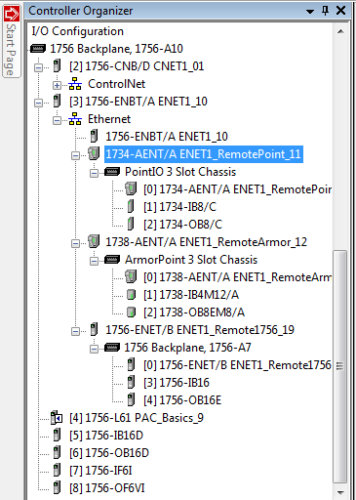 As early adopters of Ethernet/IP Distributed I/O know, not all traffic can be handled efficiently with a standard “layer 2” Ethernet Switch.
As early adopters of Ethernet/IP Distributed I/O know, not all traffic can be handled efficiently with a standard “layer 2” Ethernet Switch.
This includes Multicast traffic using Internet Group Management Protocol (IGMP,) which was initially how most (if not all) Ethernet/IP Distributed I/O was controlled.
When a standard “layer 2” Switch encounters IGMP Multicast traffic, it has no ability to identify the destination of the traffic since Multicast messages don’t use MAC address as destinations.
So without the ability to route Multicast traffic, a standard “layer 2” Switch reverts to the effective but wholly inefficient solution of rebroadcasting the Multicast traffic to all ports.
To address this issue without requiring users to upgrade to more expensive Switches supporting all “layer 3” functionality, many industrial switch manufacturers simply added “IGMP Snooping and Querying” to their “layer 2” Switches.
The “IGMP Snooping and Querying” feature provides Switches with the ability to “listen in” or “snoop on” IGMP traffic, as well as maintain a table of which ports need which traffic, so the Switch can effectively route that traffic to the correct ports.
For more information on IGMP Snooping and Querying, see this article HERE.
Well, those are what I see as the most important wired Ethernet basics everyone should know.
If you think I should have added something else, or have any questions, comments, or suggestions, please feel free to post the by clicking on the “Click here to post a comment or question” link below.
You can also check out our other Ethernet articles using the links below my signature (coming soon.)
Until next time, Peace ✌️
If you enjoyed this content, please give it a Like, and consider Sharing a link to it as that is the best way for us to grow our audience, which in turn allows us to produce more content 🙂
Shawn M Tierney
Technology Enthusiast & Content Creator
Support our work and gain access to hundreds members only articles and videos by becoming a member at The Automation Blog or on YouTube. You’ll also find all of my affordable PLC, HMI, and SCADA courses at TheAutomationSchool.com.
- FactoryTalk Design Workbench First Look, CCW Comparison - December 19, 2025
- Drew Allen of Grace Technologies on Automation, Safety, and More (P256) - December 17, 2025
- Robotics in Warehouse Automation with Erik Nieves of Plus One Robotics (P255) - December 10, 2025

Discover more from The Automation Blog
Subscribe to get the latest posts sent to your email.


